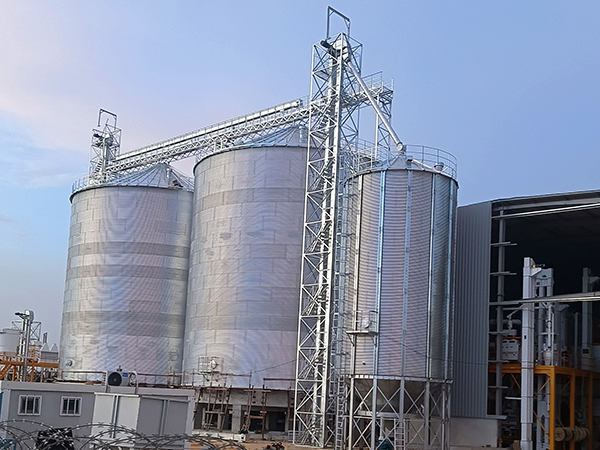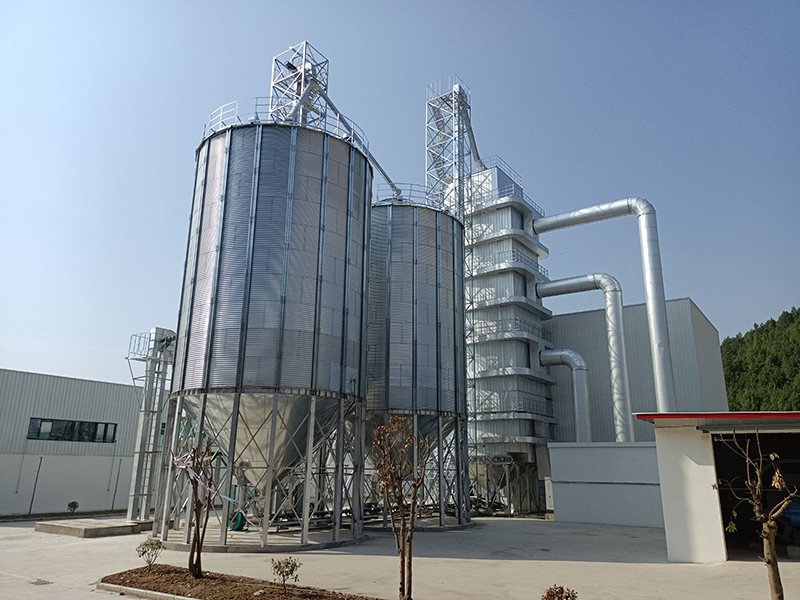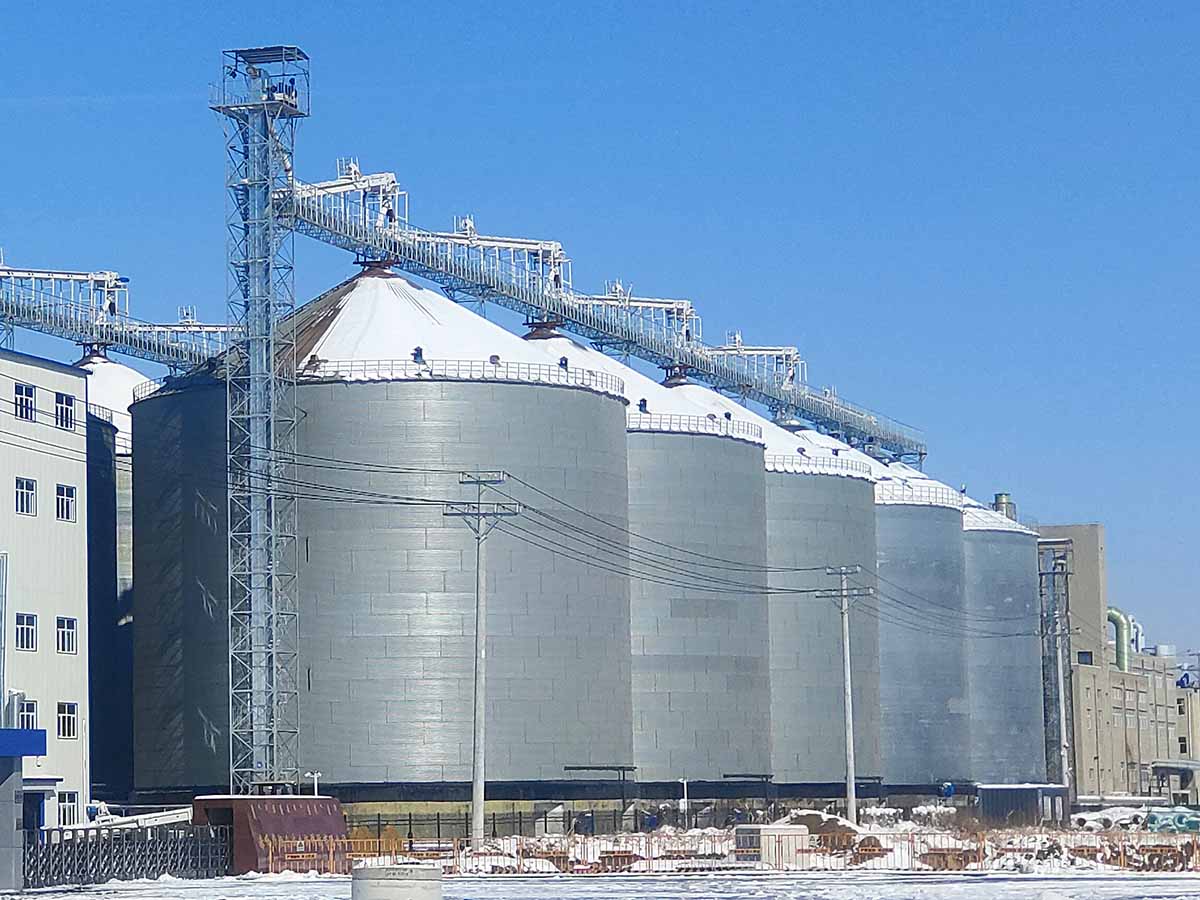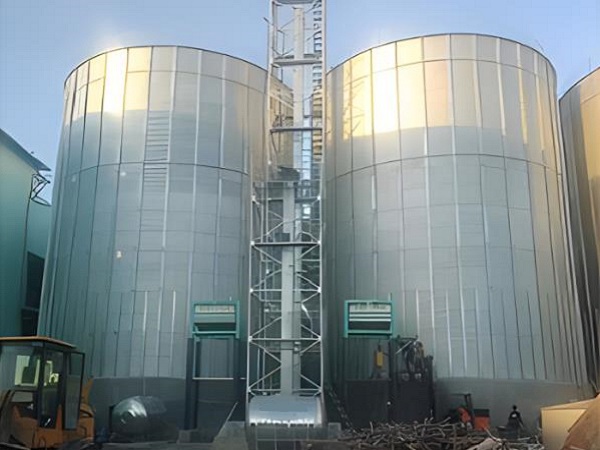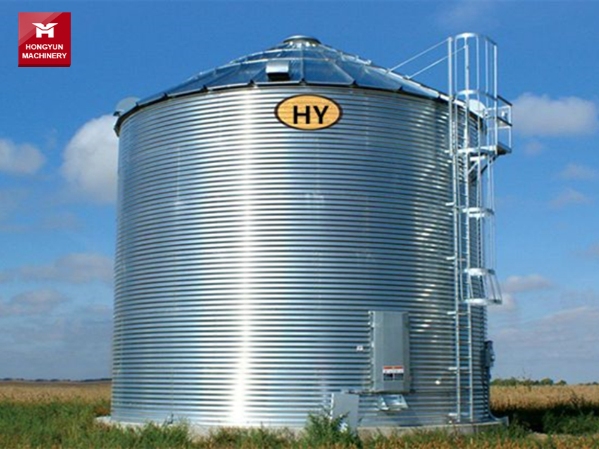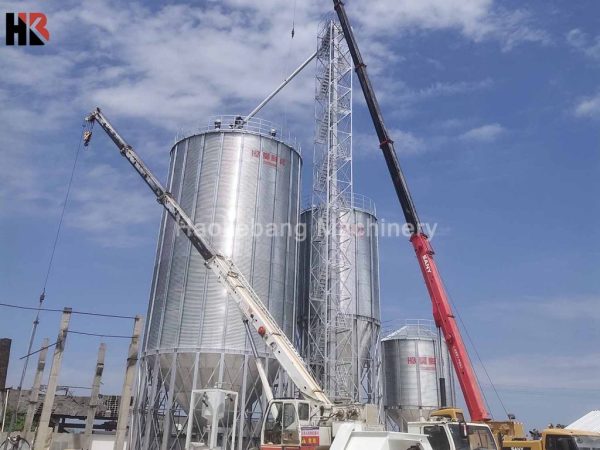Wheat flat bottom silo
Wheat flat bottom silo are storage facilities specifically designed for storing grains such as wheat, with a flat base instead of a conical shape, typically built on a concrete platform. Made from galvanized corrugated panels, these silos are assembled steel bins characterized by their large storage capacity.
Wheat flat bottom silo Introduction
Wheat flat bottom silo are storage facilities specifically designed for storing grains such as wheat, with a flat base instead of a conical shape, typically built on a concrete platform. Made from galvanized corrugated panels, these silos are assembled steel bins characterized by their large storage capacity.

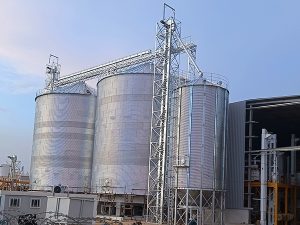
Features of wheat flat bottom silo
Flat Bottom Design
Unlike traditional conical bottom silos, flat-bottom silos have a level base, which aids in the even distribution of grain during storage and reduces potential accumulation issues caused by the shape of the bottom.
Large Capacity Storage
Flat-bottom silos are capable of holding substantial amounts of wheat, with designs ranging from small storage units to large-scale systems, all customizable to meet actual storage needs.
Durable Materials
Typically constructed from durable materials such as galvanized corrugated panels, these silos offer good corrosion resistance and strength to protect the stored wheat from environmental influences.
Easy Maintenance and Cleaning
The interior of flat-bottom silos is straightforward with smooth walls, devoid of steps or flanges, facilitating easy maintenance and cleaning.
Efficient Loading and Unloading Systems
Equipped with bottom discharge augers and scrapers, these silos ensure smooth discharge of wheat, making loading and unloading convenient.
Adaptability
Flat-bottom silos can be tailored to different storage requirements and site conditions, providing suitable storage solutions for everything from small farms to large grain processing plants.
Environmental and Safety Considerations
The design of flat-bottom silos often incorporates environmental and safety features, with a fully enclosed structure that effectively keeps out moisture and prevents animal entry, ensuring the quality and safety of the wheat.
Integrated Control Systems
Modern flat-bottom silos may come with integrated control systems for automated management, enhancing storage efficiency and reducing human errors.

Wheat flat bottom silo structure
Silo Roof
The roof is the uppermost part of the silo, designed to withstand external environmental factors such as rain and snow. It typically features waterproofing and snow load resistance to ensure that the stored wheat remains undamaged by moisture and weather conditions.
Silo Walls
The walls form the main structure of the silo, often constructed from durable materials like galvanized corrugated panels, providing the necessary strength and corrosion resistance. The wall design also considers the aeration and temperature-humidity control of the wheat stored inside.
Platform Foundation
The foundation is the supporting structure of the silo, usually built on a concrete platform to prevent moisture from the ground and to provide a stable support.
Silo Bottom
The bottom of the silo is where the wheat is stored and is designed as a flat surface, facilitating even distribution of the grain and easy discharge.
Discharge System
Located at the bottom of the silo, the discharge system includes augers, scrapers, or other machinery that helps to smoothly move the stored wheat out of the silo for loading and transportation.
Inlet and Outlet Hatches
These are located on the sides or top of the silo and are used for loading and unloading operations. They typically come with sealed hatches to prevent external contaminants from entering.
Ventilation System
To control the temperature and humidity inside the silo, a ventilation system is essential for maintaining the quality of the wheat and preventing issues such as mold growth.
Monitoring and Control System
Modern wheat platform silos may also be equipped with advanced monitoring and control systems for real-time tracking of environmental conditions inside the silo, ensuring the safe storage of wheat.

Advantages of wheat flat bottom silo
Structural Form
Flat-bottom silos are typically made of steel plates, assembled and welded together with corrugated panels or flat plates to form a closed cylindrical structure. The body of the silo includes components such as wall panels, columns, manholes, ladders, and is topped with a cover or roof structure to ensure the overall sealing and stability of the silo.
Bottom Design
As the name suggests, flat-bottom silos have a flat base that fully contacts the ground. This design allows for a larger bottom area of the silo, which evenly distributes the weight of the stored material, reducing the pressure per unit area and facilitating the construction of large-scale grain storage facilities in areas with simpler foundation preparation or less ideal geological conditions.
Capacity Scale
The capacity of flat-bottom wheat silos ranges widely, from small-scale hundreds of tons to large-scale thousands or even tens of thousands of tons. This meets the storage needs of different scales of grain reserve and processing enterprises.
Inlet and Outlet System
Flat-bottom silo usually adopt top feeding, where wheat is conveyed into the top inlet of the silo via输送 devices such as elevators or screw conveyors. Discharging is typically done through the bottom outlet device of the silo, which may include pneumatic conveying systems (using air pressure differences to move materials), gravity self-flow discharge, or mechanical discharge equipment. The flat-bottom design facilitates the installation of efficient discharge equipment and ensures that materials can be smoothly and uniformly discharged from the bottom of the silo.
Foundation and Installation
Flat-bottom grain steel silos are generally installed on flat or conical concrete foundations, which provide good support and moisture-proof performance. There is usually a moisture-proof layer and sealing measures between the silo and the foundation to ensure that the grain is not affected by moisture during long-term storage.
Sealing Performance
Due to their closed design, flat-bottom wheat silos have good functions of pest control, rodent-proofing, moisture-proofing, and mold prevention, which helps maintain the quality of wheat and reduce losses during storage. High-quality sealing materials and craftsmanship ensure a stable internal environment within the silo, suitable for long-term storage of wheat and other grains.
Additional Facilities
According to needs, flat-bottom silos can also be equipped with auxiliary equipment such as dryers to ensure that the wheat stored has the appropriate moisture content, preventing mold and spoilage due to excessive humidity. Additionally, silos may be equipped with intelligent management facilities such as temperature monitoring and ventilation systems to achieve real-time monitoring and control of the storage environment.
Application scope of wheat flat bottom silo
Coban Silo is widely used for grains storage such as wheat, corn, soybean, paddy, rice, soybean meal, barley, malt, sunflower seeds, rapeseeds, peanuts, flour, and other powder materials, oat, special Silo, and seeds, etc.

wheat flat bottom silo technical parameters
Scientifically speaking, the Silo capacity should be measured with volume (m3). Even in the same grain Silo, the storage tons will be different for different grains with different densities. The following table is calculated based on a Silo density of 0.75kg/m3, and surely HKB customizes Silo systems unique for you.
| Most Popular Hopper Bottom Steel Silo Technical Specifications | ||||||||
| Capacity | 50Ton | 100Ton | 150Ton | 200Ton | 300Ton | 500Ton | 1000Ton | 1500Ton |
| Model | TCZK
03605 |
TCZK
04507 |
TCZK
05507 |
TCZK
06406 |
TCZK
07307 |
TCZK
07313 |
TCZK
11010 |
TCZK
12811 |
| Diameter(m) | 3.667 | 4.584 | 5.500 | 6.417 | 7.334 | 7.334 | 11.000 | 12.834 |
| Total Height(m) | 9.56 | 12.53 | 13.25 | 12.85 | 14.70 | 21.42 | 20.95 | 23.51 |
| Volume(m³)
Density:0.75ton/m³ |
69 | 150 | 222 | 273 | 415 | 699 | 1346 | 2039 |
| Most Popular Flat Bottom Steel Silo Technical Specifications | ||||||||
| Capacity | 1000Ton | 1500Ton | 2000Ton | 2500Ton | 3000Ton | 5000Ton | 8000Ton | 10000Ton |
| Model | TCK
10014 |
TCK
11915 |
TCK
13715 |
TCK
15514 |
TCK
15518 |
TCK
18321 |
TCK
24718 |
TCK
25621 |
| Diameter(m) | 10.084 | 11.918 | 13.750 | 15.584 | 15.584 | 18.334 | 24.751 | 25.668 |
| Total Height(m) | 18.69 | 20.34 | 20.87 | 20.30 | 24.78 | 28.60 | 26.99 | 30.60 |
| Volume(m³)
Density: 0.75ton/m³ |
1335 | 2009 | 2701 | 2467 | 4145 | 6693 | 10879 | 13484 |
After-sale Service
- – HKB provides advanced grain safety storage technology to assure your grain silo 100% quality stability.
- – grain silo Quality guarantee is one year after installation and commissioning or 18 months after leaving China Port. Maturity is the first.
- – 7 days x 24 hours service, within 24 hours reply/solve of any technical issues upon request.
- – Routinely telephone track to remove all might be problems grain silo or issues guarantying the whole system grain silo long-lasting safety and reliability.
- – HKB will consider all other needs like customs clearance, sea delivery, insurance, customs tax benefit plan, documentation, etc. So our respected Users feel so relaxed and easy to get the grain silo system well.

